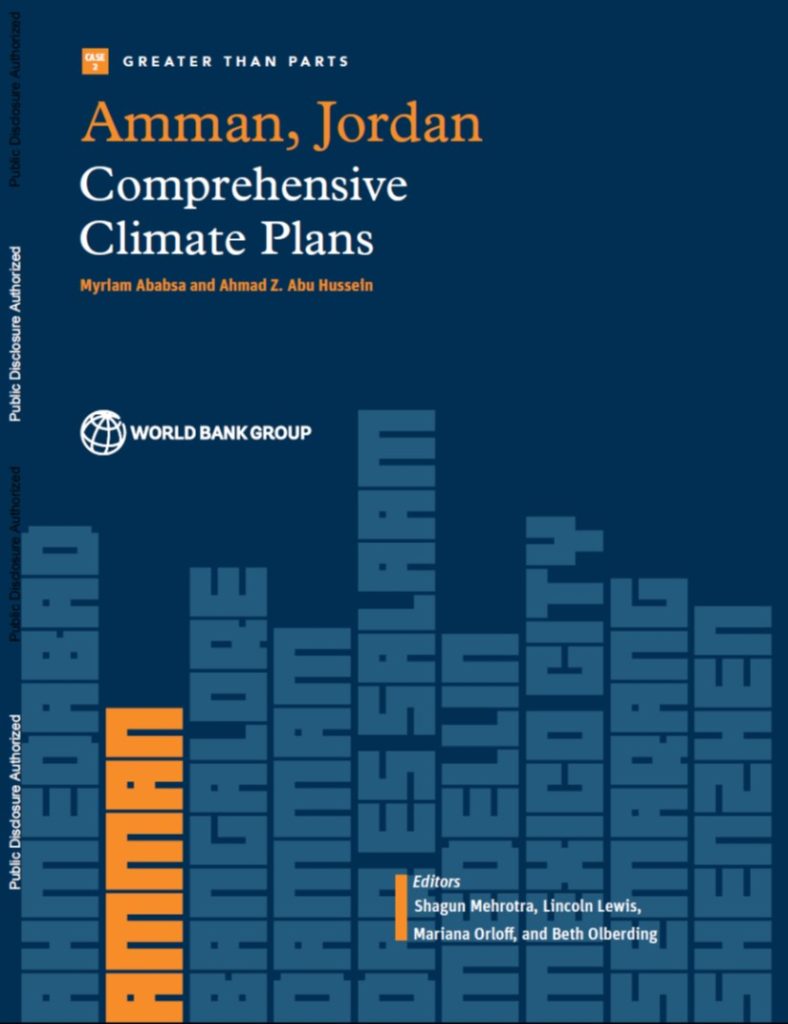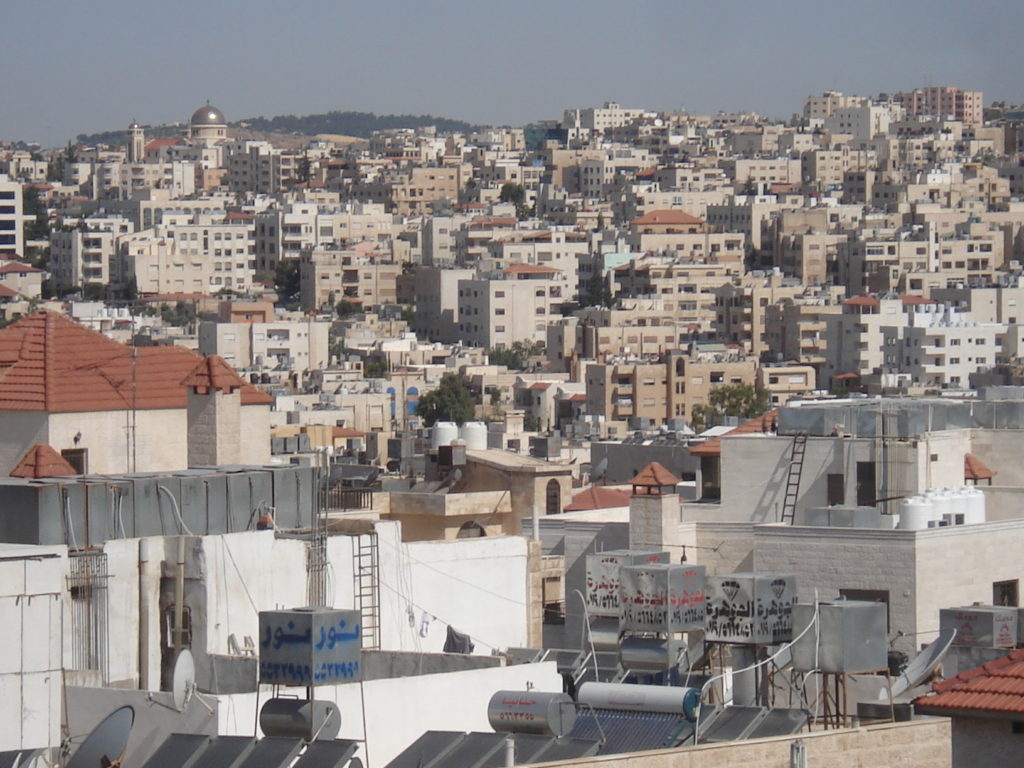I am a big fan of the work of the urban geographer Myriam Ababsa. Her spatial analysis of Amman has changed the way I view the city. Her work is an excellent example of the power of data analysis in laying out facts and helping us acknowledge, understand and address the complex realities of our cities.
I was excited to see that she has recently co-authored a report for the World Bank on metropolitan planning in Amman. True to her style, the report is well-worth the read. Ababsa and her co-author Ahmad Abu Hussein describe some of the key plans, policies and initiatives implemented by various government actors over the past 30 years in Amman to alleviate the urban challenges faced by the fast-growing city. More importantly, they reflect critically on the successes and failures of some of the policy levers and implementation mechanisms.
The report presents an honest examination providing critical yet constructive feedback of the kind that is sorely missed in the Arab world. It is the kind of feedback from which many city actors (government authorities, citizen groups, developers… etc) can learn and benefit.

As a taster, I have highlighted below some of the key messages and takeaways I found to be particularly relevant to cities in the region on their journeys towards sustainable development and integrated and inclusive planning.
1. The politics of urban sprawl
According to the Basic Business as Usual scenario, if no urban policy is conducted, Amman’s consumption of city land will increase by 14 percent between 2015 and 2030, in the amount of 41.44 square kilometers. Almost half of this growth (17 km2) is expected to happen outside zoned areas. Green or arable lands in the east and south of Amman are likely to be converted to urban use. This business-as-usual scenario consumes most land, costs the most in terms of service delivery, and produces much more pollution. It may be the most likely scenario in Russeifa and Zarqa, where urban planning is weak and where political pressure is exerted on the mayors and the elected municipal council members to expand the zoned areas.
pg 30 – 31
The decentralization law, adopted in 2015, gave much power to the members of the elected municipal councils (outside Greater Amman). Those councils are now pushing to zone additional land, as they are themselves under direct pressure from land owners wishing to benefit from the land gains. In turn, the head of the planning department is under pressure from elected local councils. These councils often only think of providing services to their own areas, without taking wider comprehensive planning into consideration. The executive director can make suggestions to extend zoned areas in order to please some city dwellers. As a result, informal urban sprawl is still occurring.
pg 28-29
The point is compact growth may be the favored option both economically and environmentally and still not be the option implemented. Speculative landowners who invest in the land beyond the current zoning/growth boundary stand to lose from a compact planning model.
The planning and permitting authorities to need the technical capacity and political power to push through the plans which benefit the majority over the long term. Otherwise, urban sprawl will continue to be the reality and will continue to be subsidized through government-funded infrastructure.
2. Metropolitan planning and cooperation
The 2008 Metropolitan Growth Master Plan is based on densification and intensification along development corridors. It fosters transit-oriented development to reduce traffic congestion and the sprawl of informal settlements. However, this integrated urban planning concerns only Greater Amman and does not include adjacent cities. As a consequence, the city of Zarqa is not represented in the technical committee for the implementation of the BRT system linking both cities. Only Greater Amman, the Ministry of Transport, the
pg 17-18
Land Transport Commission, and the French Development Agency are members of the technical committee, which points to a lack of integrated planning at the metropolitan level.
Greater Amman has not developed institutional relations with the large cities of Russeifa and Zarqa, which comprise the larger metropolitan area. Those cities are struggling to limit their urban sprawl and implement zoning regulations. Municipalities are not empowered with the ability to prepare their own masterplans, and lack the staff, equipment, and training to do so. They may only update their land use plans.
pg 19
Many ambitious strategies and projects Amman wish to implement will only be successful through the cooperation of neighboring cities that form the larger metropolitan area. This is true for most other major cities.
As planners, we sometimes forget that municipal boundaries do not mean much to anyone but ourselves. The movement of people and goods, business and personal relationships, environmental corridors, and ecosystems all stop at municipal boundaries.
Integrated city planning is a must; however, it is not enough. With all its political challenges, metropolitan planning is also necessary, especially when urban areas are close. With the competitiveness mindset, we can easily overlook the synergies and symbiotic relationships which can be fostered within a metropolitan area. As the report title highlights, metropolitan planning presents opportunities greater than the sum of the parts.
3. Getting Public Private Partnership (PPP) right
The Decent Housing for a Decent Living project was unsuccessful due to its inability to target public subsidies toward the needy segments of the population, as well as to its high cost to the government as a subsidy-driven program. Developers were paid JD 265 dinars ($373) per square foot, and the apartments were sold to the applicants for JD 220 ($310) per square foot. This was very costly to the government. In a functioning PPP, the rate of return for the private sector must be large enough to attract private investments yet small enough to protect public interest. Such PPPs must include clear provisions for monitoring, marketing, and credit facilitation. In the case of this project, building maintenance costs were not taken into consideration.
pg 32
In the age of low oil prices and increasing government deficits, PPP arrangements are sometimes made to seem like the silver bullet, the magic solution for all financing problems. We hear less about the requirements for a successful PPP and the stories of failure where these have not been met. PPP models have a role to play, but they require mature and robust governance models as well as clarity and transparency. A huge topic, perhaps for another day.

4. Save some space for the public parks
Greater Amman currently faces difficulties acquiring land to create public parks, because since the mid-2000s land has become too expensive. Gardens and open space constituted less than 1.1 percent of the total area in 2015, with 9.1 square kilometers, which equaled just 2.2 square meters per inhabitant. In 2019 this figure increased to 11.7 square kilometers, including 8.6 square kilometers of parks. This is a major issue for the residents’ well-being. The World Health Organisation recommends a minimum of 9 square meters per resident, and if possible 50 square meters (Russo and Cirella 2008).
pg 34
Even on the basic metric of square meters per resident, Amman is struggling. I say basic because really we should also be looking at the accessibility and functionality of these parks and open spaces (e.g., what percentage of the population has a park within walking distance? which activities do the parks facilitate?). Ideally, space for parks and open spaces would be safeguarded as part of the zoning process.
This challenge is not unique to Amman. I was on a tour of community gardens in Paris last year, and land ownership was the number one challenge facing any of the neighborhood groups looking to set up a community garden.
Interestingly, Amman has trialed some solutions.
5. Green infrastructure doesn’t have to be big
In 2017, Greater Amman launched a green infrastructure project in the city’s poor and dense neighborhoods. This project promotes walkability and increases pedestrian safety by linking upgraded informal areas to the BRT lines through staircase renovation. The 5-million-euro project (July 2017–July 2021) is being implemented by the German development agency Gesellschaft für Internationale Zusammenarbeit (GIZ), in partnership with Jordan’s Ministry of Environment and Greater Amman, with funding from the German development ministry
pg 15
Bundesministerium für wirtschaftliche Zusammenarbeit und Entwicklung(BMZ) and GIZ expertise. It aims at improving living conditions in poverty-stricken areas in Amman by rehabilitating stair networks that connect poor neighborhoods with BRT bus stations in Ras al Ayn (in Badr and Basman) and through the creation of two small community parks. These small projects focus on both greening and walkability.
What I love about this project is its scale. Somehow ‘green infrastructure’ has come to mean big, flashy projects, which often turn into ‘white elephants’ due to their high capital and maintenance costs (see interesting article here describing case studies of this in the city of Baltimore, USA). Focusing on smaller-scale neighborhood parks and public spaces, which also serve as safe connections to public transport, is a brilliant idea. I can’t wait to see what this looks like, how it’s received, and where it can be replicated.
While I draw out some lessons from Amman in this post, I am in no way dismissing or belittling the city’s planning achievements and the good work that is going on and deserves to be celebrated. Amman has a strategic development plan, a resilience strategy, and a climate action plan. It is going through the process of implementing these with all the challenges and learning that naturally come with them. Accepting that there will be mistakes and engaging reflectively in past experiences is the first step towards further improvements and more success.

